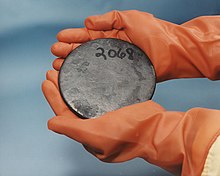Chemical element with atomic number 92 (U)
Uranium, 92 U Pronunciation (yuu-RAY -nee-əm Appearance silvery gray metallic; corrodes to a spalling black oxide coat in air
Atomic number (Z ) 92 Group f-block groups (no number)Period period 7 Block f-block Electron configuration [Rn ] 5f3 6d1 7s2 Electrons per shell 2, 8, 18, 32, 21, 9, 2 Phase at STP solid Melting point 1405.3 K (1132.2 °C, 2070 °F) Boiling point 4404 K (4131 °C, 7468 °F) Density (at 20° C) 19.050 g/cm3 [ 3] when liquid (at m.p. ) 17.3 g/cm3 Heat of fusion 9.14 kJ/mol Heat of vaporization 417.1 kJ/mol Molar heat capacity 27.665 J/(mol·K) Vapor pressure
P (Pa)
1
10
100
1 k
10 k
100 k
at T (K)
2325
2564
2859
3234
3727
4402
Oxidation states common: +6 [ 4] ? ? [ 5] [ 6] [ 6] Electronegativity Pauling scale: 1.38 Ionization energies 1st: 597.6 kJ/mol 2nd: 1420 kJ/mol Atomic radius empirical: 156 pm Covalent radius 196±7 pm Van der Waals radius 186 pm Spectral lines of uraniumNatural occurrence primordial Crystal structure orthorhombic (oS4 ) Lattice constants a = 285.35 pmb = 586.97 pmc = 495.52 pm (at 20 °C)[ 3] Thermal expansion × 10−6 [ a] Thermal conductivity 27.5 W/(m⋅K) Electrical resistivity 0.280 µΩ⋅m (at 0 °C) Magnetic ordering paramagnetic Young's modulus 208 GPa Shear modulus 111 GPa Bulk modulus 100 GPa Speed of sound thin rod 3155 m/s (at 20 °C) Poisson ratio 0.23 Vickers hardness 1960–2500 MPa Brinell hardness 2350–3850 MPa CAS Number 7440-61-1 Naming after planet Uranus , itself named after Greek god of the sky Uranus Discovery Martin Heinrich Klaproth (1789) First isolation Eugène-Melchior Péligot (1841)
Category: Uranium references
child table, as reused in {IB-U}
^ "Standard Atomic Weights: Uranium" . CIAAW . 1999.^ Prohaska, Thomas; Irrgeher, Johanna; Benefield, Jacqueline; Böhlke, John K.; Chesson, Lesley A.; Coplen, Tyler B.; Ding, Tiping; Dunn, Philip J. H.; Gröning, Manfred; Holden, Norman E.; Meijer, Harro A. J. (2022-05-04). "Standard atomic weights of the elements 2021 (IUPAC Technical Report)" . Pure and Applied Chemistry . doi :10.1515/pac-2019-0603 . ISSN 1365-3075 . ^ a b Arblaster, John W. (2018). Selected Values of the Crystallographic Properties of Elements . Materials Park, Ohio: ASM International. ISBN 978-1-62708-155-9 ^ Th(-I) and U(-I) have been detected in the gas phase as octacarbonyl anions; see Chaoxian, Chi; Sudip, Pan; Jiaye, Jin; Luyan, Meng; Mingbiao, Luo; Lili, Zhao; Mingfei, Zhou; Gernot, Frenking (2019). "Octacarbonyl Ion Complexes of Actinides [An(CO)8 ]+/− (An=Th, U) and the Role of f Orbitals in Metal–Ligand Bonding" . Chemistry (Weinheim an der Bergstrasse, Germany). 25 (50): 11772–11784 . 25 (50): 11772– 11784. doi :10.1002/chem.201902625 . ISSN 0947-6539 . PMC 6772027 PMID 31276242 .
^ ^ a b Greenwood, Norman N. ; Earnshaw, Alan (1997). Chemistry of the Elements (2nd ed.). Butterworth-Heinemann . p. 28. ISBN 978-0-08-037941-8 ^ a b Kondev, F. G.; Wang, M.; Huang, W. J.; Naimi, S.; Audi, G. (2021). "The NUBASE2020 evaluation of nuclear properties" (PDF) . Chinese Physics C . 45 (3): 030001. doi :10.1088/1674-1137/abddae . ^ Magurno, B.A.; Pearlstein, S, eds. (1981). Proceedings of the conference on nuclear data evaluation methods and procedures. BNL-NCS 51363, vol. II (PDF) . Upton, NY (USA): Brookhaven National Lab. pp. 835 ff. Retrieved 2014-08-06 . ^ Magurno, B.A.; Pearlstein, S, eds. (1981). Proceedings of the conference on nuclear data evaluation methods and procedures. BNL-NCS 51363, vol. II (PDF) . Upton, NY (USA): Brookhaven National Lab. pp. 835 ff. Retrieved 2014-08-06 . Cite error: There are <ref group=lower-alpha> tags or {{efn}} templates on this page, but the references will not show without a {{reflist|group=lower-alpha}} template or {{notelist}} template (see the help page ).





